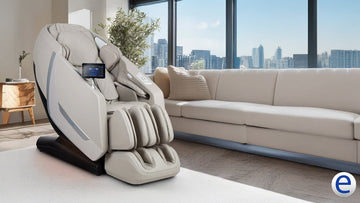Massage chair technology has advanced significantly over the past decade. What was once limited to basic rollers moving along a fixed track has now evolved into adaptive, AI-driven systems that respond to the body in real time. The terms 2D, 3D, 4D, and 5D massage chairs describe the sophistication of a chair’s roller mechanism. Knowing the distinctions is essential if you want to evaluate a chair beyond surface-level marketing.
What Exactly Is a Massage Roller?
At the core of every massage chair is the roller mechanism. These rollers are engineered to replicate the techniques of human hands, applying pressure and movement across key muscle groups.
- Construction: Typically hard composite or metal cores, often encased in urethane or silicone for durability and comfort.
- Functionality: Rollers are mounted on a track and powered by precision motors to deliver consistent, repeatable massage patterns.
- Variability: Higher-end chairs integrate multiple roller assemblies and intelligent sensors, moving well beyond simple mechanical motion.
If you want more on how rollers compare with track systems, see our guide on SL-Track vs L-Track Massage Chairs.
The Progression of Roller Technology
2D Massage Chairs– The Baseline
- Movement: Rollers move vertically (Y-axis) and horizontally (X-axis).
- Limitations: No depth adjustment; pressure is determined by track design and user body type.
- Use Case: Basic relaxation, entry-level users
- Recommended Model: Synca Circ, Osaki Ziva, Inner Balance Jin 2.0
3D Massage Chairs Depth Control Introduced
- Movement: Adds forward/backward motion (Z-axis).
-
Advantage: True depth control—rollers can penetrate deeper into muscle tissue or retract for lighter intensity.
- Use Case: Users requiring adjustable intensity, especially for chronic back and shoulder tension.
- Recommended Model: Osaki OS-3D AI Vito, Ogawa Active XL 3D, Osaki Pro Admiral II
4D Massage Chairs - Variable Speed & Technique Simulation
- Movement:Builds on 3D, introducing speed variation and rhythm control.
- Advantage:More accurately simulates human massage techniques such as kneading, shiatsu, and tapping, where timing and tempo matter as much as depth.
- Use Case: dividuals seeking a realistic, spa-grade massage experience.
- Recommended Model: Osaki Pro Maestro 2.0, Osaki 4D Manhattan, Fujiiryoki Cyber Relax Pro, Osaki Trion Flex Duo, Osaki OS-Pro 4D Duomax
5D Massage Chairs – Adaptive Intelligence
- Movement: Everything in 4D, with real-time AI adjustments.
- Advantage: Rollers respond dynamically based on body scanning, pressure sensors, and usage data. The chair adapts to muscle density, posture, and user preference without manual recalibration.
- Use Case: Multi-user environments and discerning buyers who want the most advanced, therapist-level experience available in consumer massage chairs.
- Recommended Model: Synca JP3000, Fujiiryoki Cyber Relax 5.0
Comparison Matrix
| Type | Axes of Motion | Key Differentiator | Primary Value |
|---|---|---|---|
| 2D | X + Y | Entry-level coverage | Budget accessibility |
| 3D | X + Y + Z | Depth/intensity control | Therapeutic versatility |
| 4D | 3D + Variable Speed | Lifelike timing & rhythm | Realism and precision |
| 5D | 4D + AI / Adaptive | Real-time personalization | Maximum customization |
See our Top 10 Massage Chairs of 2025 for detailed model comparisons.
Expert Perspective
From an engineering and therapeutic standpoint, the jump from 2D to 3D is the most impactful for users needing relief beyond casual relaxation. The move to 4D enhances realism and flow, while 5D introduces intelligent responsiveness — the ability for the chair to actively adjust mid-session.
For more on the health side, check out Mayo Clinic’s research on massage therapy benefits.
Additional Resources
Frequently Asked Questions
Anyone who needs adjustable intensity for back/shoulder relief. 3D’s Z-axis depth lets you dial pressure in or out—something 2D cannot do. See options: Best 3D massage chairs.
L-Track follows the spine down to the glutes; S-curve follows natural back curvature; SL-Track blends both. Flex Track adds controlled flex for more effective stretching and fit. Read the guide: SL-Track vs L-Track.
Yes. 4D controls timing/tempo similar to a therapist’s pacing. 5D adds real-time adaptation so pace and depth evolve as your muscles relax. See our Top 10 Massage Chairs.
Yes—look for AI body scan, user memory profiles, and quick intensity toggles. Dual-mechanism and 5D systems adapt fastest across body types. For personalized picks: Get recommendations.





